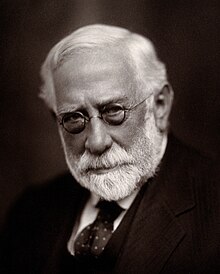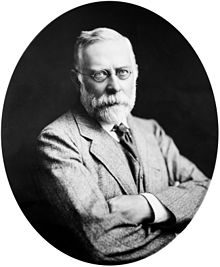Sir Thomas Barlow, 1st Baronet
Sir Thomas Barlow, 1st Baronet | |
|---|---|
 |
Sir Thomas Barlow, 1st Baronet,KCVO,FRS,FRCP[1](4 November 1845 – 12 January 1945) was a British royalphysician,known for his research on infantilescurvy.
Early life
[edit]

Barlow was the son of aLancashirecottonmanufacturer and Mayor of Bolton,James Barlow(1821–1887). The family were well known as philanthropists in their home village ofEdgworth,Lancashirewhere they funded charities connected with theMethodistchurch including theChildren's Home.
He studied as anundergraduateat Manchester and London.University College London(UCL)Bachelor of Medicine(BM) in 1873 andDoctor of Medicine(MD) 1874.
Career
[edit]He became aregistraratGreat Ormond Street Hospital,and later aphysicianand in 1899 aconsultant.He wasprofessorat the UCL from 1895 to 1907, initially of paediatrics and later ofclinical medicine.
In 1883, he showed that infantile scurvy was identical with adult scurvy.Barlow's disease– infantile scurvy – is named after him.[2]
He wasRoyal PhysiciantoQueen Victoriaand attended her on her death, and toEdward VIIandKing George V. He was knighted as aKnight Commander of the Royal Victorian Orderin March 1901,[3]and in February 1902 he was created aBaronet,of Wimpole Street in St Marylebone in the County of London.[4]He was President of theRoyal College of Physiciansfrom 1910–1914 and delivered theirHarveian Orationin 1916 on the subject ofHarvey, The Man and the Physician.He was elected a Foreign Honorary Member of theAmerican Academy of Arts and Sciencesin 1918.[5]
Barlow received thehonorary degreeDoctor of Science(D.Sc.) from theVictoria University of Manchesterin February 1902, in connection with the 50th jubilee celebrations of the establishment of the university.[6]In 1904, he waslisted honorary medical staffatKing Edward VII's Hospital for Officers.[7]
Marriage and children
[edit]Barlow married Ada Helen Dalmahoy, daughter of Patrick DalmahoyWS,on 28 December 1880. They had the following children:
- SirJames Alan Noel Barlow,2nd Bt. (1881–1968), who marriedEmma Nora Darwin,the granddaughter ofCharles Darwin(seeDarwin — Wedgwood family).
- SirThomas Dalmahoy Barlow(1883–1964)
- Patrick Basil Barlow (23 October 1884 – 18 January 1917), killed in theFirst World War[8]
- Helen Alice Dorothy Barlow (4 May 1887 – 16 September 1975), died unmarried - seeRe Barlow's Will Trusts.With her father, she was a member of theLondon Survey Committee,a voluntary organisation publishing architectural surveys of the capital.[9]
- Gertrude Mary Barlow (August 1888 – 22 July 1889), died in infancy
Death and legacy
[edit]He died 12 January 1945[10][11]at 10Wimpole Street,London[12]aged 99. Barlow's papers are preserved in the archive of theWellcome Library.[12]
References
[edit]- ^Elliott, T. R. (1945). "Thomas Barlow. 1845-1945".Obituary Notices of Fellows of the Royal Society.5(14): 158–167.doi:10.1098/rsbm.1945.0010.S2CID162240383.
- ^Carpenter, Kenneth J. (1988).The History of Scurvy and Vitamin C.Cambridge University Press.p. 172.ISBN0-521-34773-4.
- ^"No. 27292".The London Gazette.8 March 1901. p. 1647.
- ^"No. 27409".The London Gazette.21 February 1902. p. 1118.
- ^"Book of Members, 1780–2010: Chapter B"(PDF).American Academy of Arts and Sciences.Retrieved17 May2011.
- ^"University intelligence".The Times.No. 36704. London. 1 March 1902. p. 12.
- ^"List of Honorary Medical Staff of the Hospital".King Edward VII's Hospital for Officers (Sister Agnes). Historical Record 1899-1969(3rd ed.). London: Beaumont House. 1969. pp. 20–21.
- ^CWGC:: Casualty Detailsat www.cwgc.org
- ^"Members of the Survey Committee Pages 4-7 Survey of London Monograph 12".British History Online.Guild & School of Handicraft, London, 1926.Retrieved27 February2024.
- ^Medical Press.1945. pp. 96, 110.
- ^Harvard Alumni Bulletin - Volume 47, Issue 13 - Page 416
- ^ab"Barlow, Sir Thomas (1845-1945)".Wellcome Library Western Manuscripts and Archives catalogue.Wellcome Library.Retrieved31 May2011.
External links
[edit]- 1845 births
- 1945 deaths
- 19th-century English medical doctors
- 20th-century English medical doctors
- Academics of University College London
- Alumni of University College London
- Barlow baronets
- British paediatricians
- Fellows of the American Academy of Arts and Sciences
- Fellows of the Royal College of Physicians
- Fellows of the Royal Society
- Knights Commander of the Royal Victorian Order
- People from Edgworth
- Honorary medical staff at King Edward VII's Hospital for Officers
